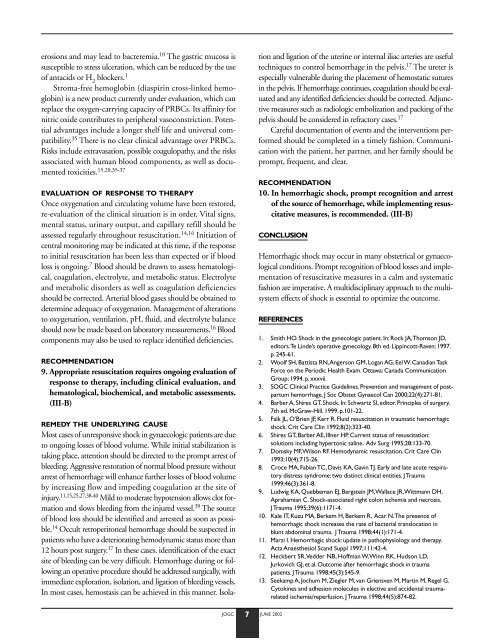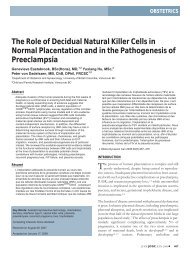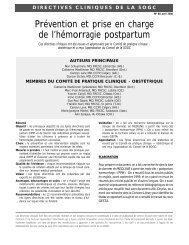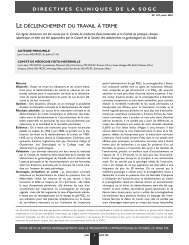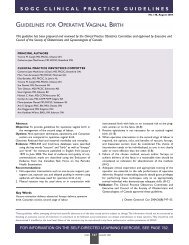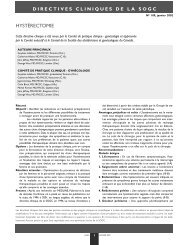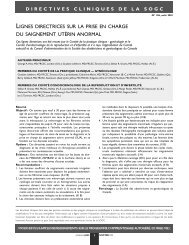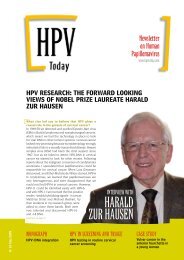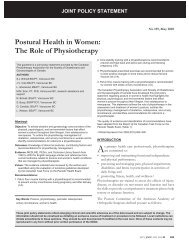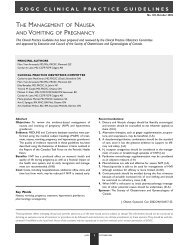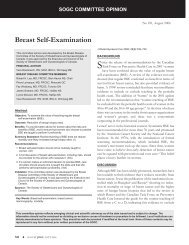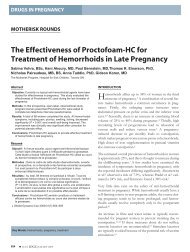Hemorrhagic Shock - SOGC
Hemorrhagic Shock - SOGC
Hemorrhagic Shock - SOGC
You also want an ePaper? Increase the reach of your titles
YUMPU automatically turns print PDFs into web optimized ePapers that Google loves.
erosions and may lead to bacteremia. 10 The gastric mucosa is<br />
susceptible to stress ulceration, which can be reduced by the use<br />
of antacids or H 2 blockers. 1<br />
Stroma-free hemoglobin (diaspirin cross-linked hemoglobin)<br />
is a new product currently under evaluation, which can<br />
replace the oxygen-carrying capacity of PRBCs. Its affinity for<br />
nitric oxide contributes to peripheral vasoconstriction. Potential<br />
advantages include a longer shelf life and universal compatibility.<br />
35 There is no clear clinical advantage over PRBCs.<br />
Risks include extravasation, possible coagulopathy, and the risks<br />
associated with human blood components, as well as documented<br />
toxicities. 15,20,35-37<br />
EVALUATION OF RESPONSE TO THERAPY<br />
Once oxygenation and circulating volume have been restored,<br />
re-evaluation of the clinical situation is in order. Vital signs,<br />
mental status, urinary output, and capillary refill should be<br />
assessed regularly throughout resuscitation. 14,16 Initiation of<br />
central monitoring may be indicated at this time, if the response<br />
to initial resuscitation has been less than expected or if blood<br />
loss is ongoing. 7 Blood should be drawn to assess hematological,<br />
coagulation, electrolyte, and metabolic status. Electrolyte<br />
and metabolic disorders as well as coagulation deficiencies<br />
should be corrected. Arterial blood gases should be obtained to<br />
determine adequacy of oxygenation. Management of alterations<br />
to oxygenation, ventilation, pH, fluid, and electrolyte balance<br />
should now be made based on laboratory measurements. 16 Blood<br />
components may also be used to replace identified deficiencies.<br />
RECOMMENDATION<br />
9. Appropriate resuscitation requires ongoing evaluation of<br />
response to therapy, including clinical evaluation, and<br />
hematological, biochemical, and metabolic assessments.<br />
(III-B)<br />
REMEDY THE UNDERLYING CAUSE<br />
Most cases of unresponsive shock in gynaecologic patients are due<br />
to ongoing losses of blood volume. While initial stabilization is<br />
taking place, attention should be directed to the prompt arrest of<br />
bleeding. Aggressive restoration of normal blood pressure without<br />
arrest of hemorrhage will enhance further losses of blood volume<br />
by increasing flow and impeding coagulation at the site of<br />
injury. 11,15,25,27,38-40 Mild to moderate hypotension allows clot formation<br />
and slows bleeding from the injured vessel. 39 The source<br />
of blood loss should be identified and arrested as soon as possible.<br />
14 Occult retroperitoneal hemorrhage should be suspected in<br />
patients who have a deteriorating hemodynamic status more than<br />
12 hours post surgery. 17 In these cases, identification of the exact<br />
site of bleeding can be very difficult. Hemorrhage during or following<br />
an operative procedure should be addressed surgically, with<br />
immediate exploration, isolation, and ligation of bleeding vessels.<br />
In most cases, hemostasis can be achieved in this manner. Isola-<br />
JOGC 7 JUNE 2002<br />
tion and ligation of the uterine or internal iliac arteries are useful<br />
techniques to control hemorrhage in the pelvis. 17 The ureter is<br />
especially vulnerable during the placement of hemostatic sutures<br />
in the pelvis. If hemorrhage continues, coagulation should be evaluated<br />
and any identified deficiencies should be corrected. Adjunctive<br />
measures such as radiologic embolization and packing of the<br />
pelvis should be considered in refractory cases. 17<br />
Careful documentation of events and the interventions performed<br />
should be completed in a timely fashion. Communication<br />
with the patient, her partner, and her family should be<br />
prompt, frequent, and clear.<br />
RECOMMENDATION<br />
10. In hemorrhagic shock, prompt recognition and arrest<br />
of the source of hemorrhage, while implementing resuscitative<br />
measures, is recommended. (III-B)<br />
CONCLUSION<br />
<strong>Hemorrhagic</strong> shock may occur in many obstetrical or gynaecological<br />
conditions. Prompt recognition of blood losses and implementation<br />
of resuscitative measures in a calm and systematic<br />
fashion are imperative. A multidisciplinary approach to the multisystem<br />
effects of shock is essential to optimize the outcome.<br />
REFERENCES<br />
1. Smith HO. <strong>Shock</strong> in the gynecologic patient. In: Rock JA,Thomson JD,<br />
editors.Te Linde’s operative gynecology. 8th ed. Lippincott-Raven; 1997.<br />
p. 245-61.<br />
2. Woolf SH, Battista RN,Angerson GM, Logan AG, Eel W. Canadian Task<br />
Force on the Periodic Health Exam. Ottawa: Canada Communication<br />
Group; 1994. p. xxxvii.<br />
3. <strong>SOGC</strong> Clinical Practice Guidelines. Prevention and management of postpartum<br />
hemorrhage. J Soc Obstet Gynaecol Can 2000;22(4):271-81.<br />
4. Barber A, Shires GT. <strong>Shock</strong>. In: Schwartz SI, editor. Principles of surgery.<br />
7th ed. McGraw-Hill. 1999. p.101-22.<br />
5. Falk JL, O’Brien JF, Kerr R. Fluid resuscitation in traumatic hemorrhagic<br />
shock. Crit Care Clin 1992;8(2):323-40.<br />
6. Shires GT, Barber AE, Illner HP. Current status of resuscitation:<br />
solutions including hypertonic saline. Adv Surg 1995;28:133-70.<br />
7. Domsky MF,Wilson RF. Hemodynamic resuscitation. Crit Care Clin<br />
1993;10(4):715-26.<br />
8. Croce MA, Fabian TC, Davis KA, Gavin TJ. Early and late acute respiratory<br />
distress syndrome: two distinct clinical entities. J Trauma<br />
1999;46(3):361-8.<br />
9. Ludwig KA, Quebbeman EJ, Bergstein JM,Wallace JR,Wittmann DH,<br />
Aprahamian C. <strong>Shock</strong>-associated right colon ischemia and necrosis.<br />
J Trauma 1995;39(6):1171-4.<br />
10. Kale IT, Kuzu MA, Berkem H, Berkem R, Acar N.The presence of<br />
hemorrhagic shock increases the rate of bacterial translocation in<br />
blunt abdominal trauma. J Trauma 1998;44(1):171-4.<br />
11. Marzi I. <strong>Hemorrhagic</strong> shock: update in pathophysiology and therapy.<br />
Acta Anaesthesiol Scand Suppl 1997;111:42-4.<br />
12. Heckbert SR,Vedder NB, Hoffman W,Winn RK, Hudson LD,<br />
Jurkovich GJ, et al. Outcome after hemorrhagic shock in trauma<br />
patients. J Trauma 1998;45(3):545-9.<br />
13. Seekamp A, Jochum M, Ziegler M, van Griensven M, Martin M, Regel G.<br />
Cytokines and adhesion molecules in elective and accidental traumarelated<br />
ischemia/reperfusion. J Trauma 1998;44(5):874-82.


